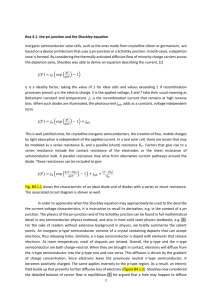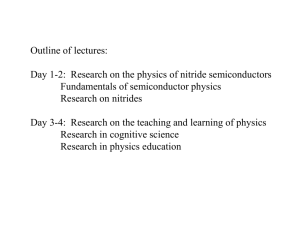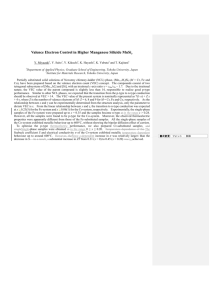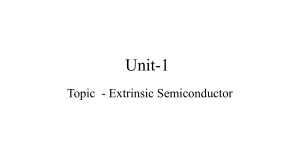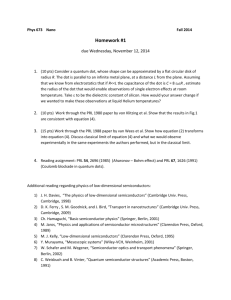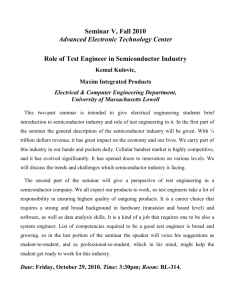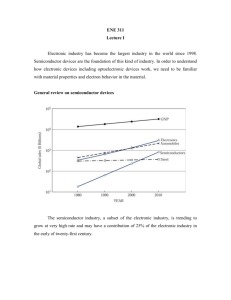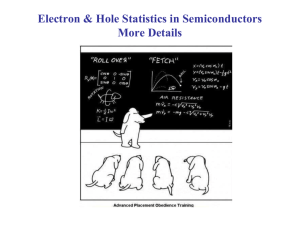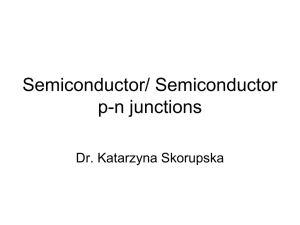Level 3 Physics Internal Assessment Resource
advertisement
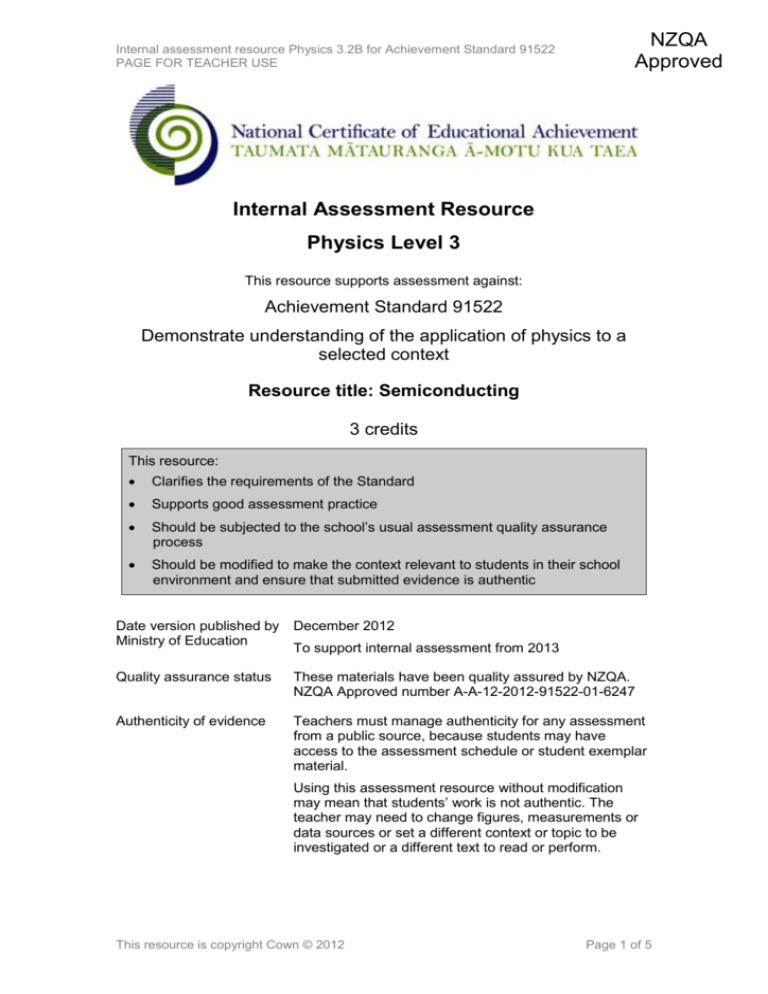
NZQA Approved Internal assessment resource Physics 3.2B for Achievement Standard 91522 PAGE FOR TEACHER USE Internal Assessment Resource Physics Level 3 This resource supports assessment against: Achievement Standard 91522 Demonstrate understanding of the application of physics to a selected context Resource title: Semiconducting 3 credits This resource: Clarifies the requirements of the Standard Supports good assessment practice Should be subjected to the school’s usual assessment quality assurance process Should be modified to make the context relevant to students in their school environment and ensure that submitted evidence is authentic Date version published by December 2012 Ministry of Education To support internal assessment from 2013 Quality assurance status These materials have been quality assured by NZQA. NZQA Approved number A-A-12-2012-91522-01-6247 Authenticity of evidence Teachers must manage authenticity for any assessment from a public source, because students may have access to the assessment schedule or student exemplar material. Using this assessment resource without modification may mean that students’ work is not authentic. The teacher may need to change figures, measurements or data sources or set a different context or topic to be investigated or a different text to read or perform. This resource is copyright Cown © 2012 Page 1 of 5 Internal assessment resource Physics 3.2B for Achievement Standard 91522 PAGE FOR TEACHER USE Internal Assessment Resource Achievement Standard 91522: Demonstrate understanding of the application of physics to a selected context Resource reference: Physics 3.2B Resource title: Semiconducting Credits: 3 Teacher guidelines The following guidelines are supplied to enable teachers to carry out valid and consistent assessment using this internal assessment resource. Teachers need to be very familiar with the outcome being assessed by Achievement Standard Physics 91522. The achievement criteria and the explanatory notes contain information, definitions, and requirements that are crucial when interpreting the Standard and assessing students against it. Context/setting This assessment activity asks students to demonstrate understanding of the application of physics to a selected context. In this case the students will apply their knowledge of circuits and semiconductor physics to the function of a semiconductor component used in an electronic device. Conditions The students may, although they are not expected to, conduct any practical experimentation to gather data for this report. The report is to be based primarily on secondary research information and the students’ knowledge of the physics theory. Their digital A2-sized posters are to be completed independently. Resource requirements Internet access The following websites may be useful: http://www.howstuffworks.com/ http://en.wikipedia.org/wiki/Main_Page. http://hyperphysics.phy-astr.gsu.edu/hbase/hframe.html Additional information None. This resource is copyright Cown © 2012 Page 2 of 5 Internal assessment resource Physics 3.2B for Achievement Standard 91522 PAGE FOR STUDENT USE Internal Assessment Resource Achievement Standard 91522: Demonstrate understanding of the application of physics to a selected context Resource reference: Physics 3.2B Resource title: Semiconducting Credits: 3 Achievement Achievement with Merit Demonstrate understanding of the application of physics to a selected context. Demonstrate in-depth understanding of the application of physics to a selected context. Achievement with Excellence Demonstrate comprehensive understanding of the application of physics to a selected context. Student instructions sheet Introduction Today’s society is very reliant on the use of electronic devices. These devices make use of semiconductors, therefore understanding how semiconductors (and the electronic components they are made of) are used in modern technology is increasingly important. This assessment activity requires you to apply your understanding of physics to a real life context. Based on the work we have done in class, you will apply your knowledge of circuits and semiconductor physics to the function of a semiconductor component used in an electronic device. You will prepare a digital A2 sized poster to report your results. You will be assessed on how well you demonstrate understanding of how semiconductor physics applies to your selected electronic device. You will not be assessed on the quality of your presentation. Task Select an electronic device from the list below as your context. If you wish to use a different device, check with your teacher to ensure that your chosen device will allow you to demonstrate comprehensive understanding. Possible electronic devices (contexts): light emitting diode (LED) photodiode bipolar junction transistor (MOSFET, CMOS, JFET) light dependent resistor (LDR) thermistor. Research your chosen electronic device. This resource is copyright Cown © 2012 Page 3 of 5 Internal assessment resource Physics 3.2B for Achievement Standard 91522 PAGE FOR STUDENT USE Using your knowledge of circuits and semiconductor physics, explain the function of a semiconductor component used in the electronic device. You are encouraged to use diagrams and pictures to support your explanations. You need to clearly link key physics ideas together to provide a coherent picture of the physics relevant to the semiconductor component. This resource is copyright Cown © 2012 Page 4 of 5 Internal assessment resource Physics 3.2B for Achievement Standard 91522 PAGE FOR TEACHER USE Assessment schedule: Physics 91522 Semiconducting Evidence/Judgements for Achievement The student has demonstrated understanding of the application of physics to a selected context by relating the key physics ideas to the selected context. For example, in the context of an LED: Evidence/Judgements for Achievement with Merit Evidence/Judgements for Achievement with Excellence Physics ideas: The student has demonstrated in-depth understanding of the application of physics to a selected context by providing reasons that explains how or why the physics applies in their context. For example, in the context of an LED: The student has demonstrated comprehensive understanding of the application of physics to a selected context by linking key physics ideas together to provide a coherent picture of the physics relevant to the selected context. For example, in the context of an LED: band structure of semiconductor described Physics ideas: Physics ideas: band structure of semiconductor described band structure of semiconductor described p-type and n-type semiconductors explained p-type and n-type semiconductors explained an explanation of the depletion zone and forward and reverse bias an explanation of the depletion zone and forward and reverse bias energy drop of electron causes light emission. energy drop of electron causes light emission. Reasons/explanations: explains how p-type and n-type semiconductors increase the number of charge carriers of different types Reasons/explanations explains how p-type and n-type semiconductors increase the number of charge carriers of different types explains why electron movement from n-type to p-type results in light emission. explains why electron movement from n-type to p-type results in light emission. p-type and n-type semiconductors described a description of the depletion zone and the p-n junction light emission linked to electron movement from n-type to p-type material. The examples above are indicative of the evidence that is required. Links the following ideas: The examples above are indicative of the evidence that is required. links band structure in p-type and n-type semiconductors to the energy of the electron in the valence and conduction bands links the loss in energy as the electron passes from one type of semiconductor to the other to the frequency and colour light emitted via E = hf. Links must be comprehensive and integrate to provide a full and complete explanation of the function of the LED. The examples above are indicative of the evidence that is required. Final grades will be decided using professional judgment based on a holistic examination of the evidence provided against the criteria in the Achievement Standard. This resource is copyright Cown © 2012 Page 5 of 5

